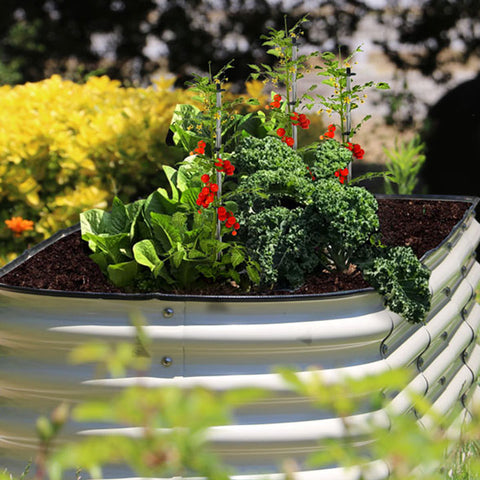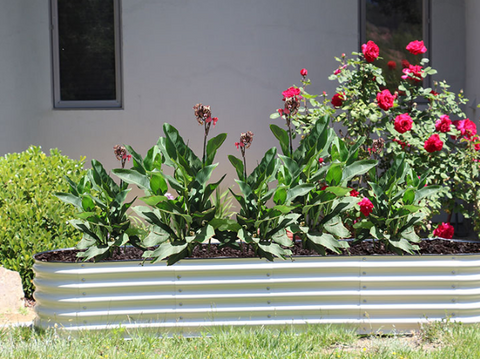Knowledge from Olle Garden Bed: Flower Fertilizer Guide
It has been said that a good garden bed starts with good soil. This is because plants depend on the soil for their livelihoods. Just as humans need protein, fat, and carbohydrates, plants need nitrogen, phosphorus, and potassium — collectively known as N-P-K.
Flower fertilizer provides nitrogen for leaf growth, phosphorus (or phosphate) for flowering and fruit formation, and potassium (or potash) for healthy root growth and development and better drought resistance. The packaging fertilizer lists the percentages of these three macronutrients on the label. Thus, a bag of fertilizer labeled 4-6-4 contains 4% nitrogen, 6% phosphorus and 4% potassium, and the rest consists of filling ingredients.
Of course, plants absorb carbon from the air and hydrogen and oxygen from the water. But they also need secondary nutrients (calcium, magnesium and sulfur) and micronutrients (boron, chlorine, copper, iron, manganese, molybdenum and zinc). Without them, they may be stunted, less productive, and have abnormal or discolored leaves.
Sandy , acidic or peat soils are most likely to lack essential nutrients, but soil testing is the only way to be sure. An electronic soil tester will discover macronutrient requirements as well as pH, which affects the availability of root nutrients. To identify micronutrient deficiencies, you can schedule a complete soil test through your partner extension service.

What fertilizer to use
Fertilizer types include granular, powdered, granular, liquid and water-soluble crystals. There are also many different recipes, some even plant-specific. For example, a fertilizer with an N-P-K ratio of 4-6-4 is ideal for heavy roses. Water-based fertilizers provide a quick boost to plants, but leach from the soil relatively quickly, so it must be reapplied every few weeks. At the same time, releasing fertilizer regularly saves time and effort because you don't have to constantly reapply it. To add to the large flower bed, try fertilizer that is connected directly to the garden hose.
When to fertilize the Garden Beds
Fertilization should be applied immediately after the resumption of growth in the spring and again after the buds have formed. If the weather is cool, use water-based fertilizers, as timed release fertilizers will not activate until the soil temperature warms. If you decide when to fertilize your raised garden bed late in the season, it's a good time before weeding – when you pull out the weeds, the fertilizer particles will come into contact with the soil. Apply evenly, scrape the fertilizer into the soil and water the raised garden bed. This will start dissolving the pellets to release fertilizer and remove any fertilizer dust that falls on the leaves.
How often to fertilize the flowers
It depends on the type of fertilizer you use, so be sure to follow the instructions on the label. Slow-release fertilizers are coated to gradually release nutrients over time. They usually last for three months or more, so they only need to be applied once or twice per growing season. Water-soluble fertilizers, on the other hand, provide nutrients that burst quickly. While they will show results quickly, they need to be reapplied every few weeks to maintain effectiveness. Some gardeners put down slow-release fertilizer at the beginning of the season and then apply a round or two of water-soluble fertilizer to kick-start growth.

Which flowers to fertilize
Annual plants in particular need regular fertilization because they actively grow and bloom throughout the season. But perennials can also benefit from fertilizers, which can help them develop better root systems to withstand drought and cold weather. Ideally, you can pair fertilizer with plants, which is especially helpful for sour-loving flowering shrubs like azaleas, azaleas, and camellias. If you have the results of a soil test, you can determine exactly what is needed and then apply it. For example, blood meal can be supplemented with nitrogen, while low-phosphorus soils can replenish bone meal.
Flowers that do not require fertilizer
Some plants are light feeders and do not require fertilization, such as aster, monada (aka bee paste), tuber tiannan (aka butterfly grass), echinacea (aka echinacea), and veronica. In some cases, too much nitrogen can even lead to weak stems and malformed growth. In general, plants that grow in the shade require less fertilizer than plants that grow in the sun. The same goes for plants covered with compost or leaf mold every year.
How fertilization affects flower health
Fertilizer is not a panacea for plant problems. Plants still need the right soil and the right level of light and humidity to grow well. Fertilizer simply provides the basic elements that plants need to do their job properly. Without these elements, plants are more susceptible to insect and disease problems as well as drought stresses. They're also less dynamic and less attractive. The leaves are often twisted and discolored, the flowers are small, in insufficient supply or completely absent.

Flower fertilizer has the ability to take garden beds up a notch in the appearance department. However, if you make sure that the plant is happy at the beginning, the results will be even more impressive.
